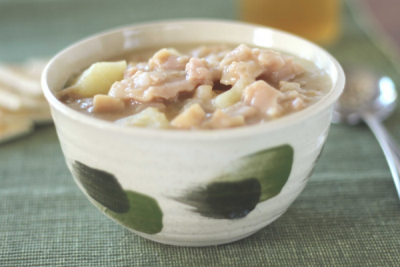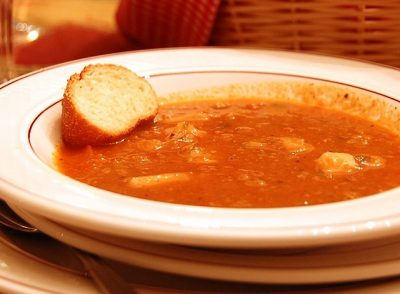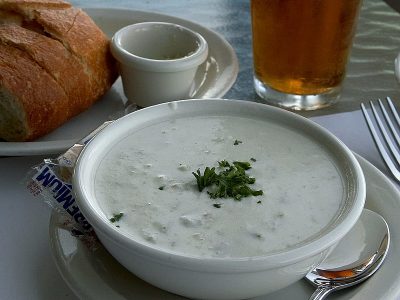Most Americans would say that the United States has two clam chowders, the creamy New England-style and the tomato-based Manhattan kind. They know this in a large part due to the Campbell’s Soup company bringing both chowders to the masses. Who didn’t grow up with Mom pouring a can of clam chowder into a pot?

I would argue there are three types of clam chowder in America, the third and best being North Carolina’s own. Some people call it “Hatteras clam chowder,” others call it “Down East clam chowder,” but most locals just call it “clam chowder” because no matter where you’re from on the N.C. coast, it’s always made with mostly clams.
Supporter Spotlight
Agreeing on a clam chowder recipe is no small deal. In New England, where those other two chowders are from, cooks constantly quarrel over which recipe is correct. Milk- or cream-based New England-style with potatoes and onions might be thick or thin. Manhattan-style seasoned with garlic and often soup vegetables such as carrots, onions and celery has many variations. Long Islanders add milk or cream. Floridians include hot chilies. In New Jersey, cooks stir in light cream, creamed asparagus and celery powder.
It was all too much for one Maine legislator to take. In the mid-1900s, New England clam chowder devotee Rep. Cleveland Sleeper was so offended by Manhattan-style chowder that he kept drafting bills to make putting tomatoes in clam chowder a crime. Offenders would have been forced to dig a barrel of clams at high tide.
The issue was supposedly finally put to rest in the so-called “Maine chowder war of 1939.” It was a chef-to-chef battle, New England vs Manhattan. New England won, and Sleeper gloated. “If a clam could vote,” he said, “I would be elected president.”
Debate, however, never ended.

Sleeper thought, as other Manhattan chowder haters still do, that tomatoes polluted the stew. So does milk or cream, as far as native coastal North Carolinians are concerned. They put nothing but clams, potatoes, onions and water in their clam chowder because they like chowder that tastes like fresh clams. What’s more accurate than that?
Supporter Spotlight
Food historians think the word “chowder” derives from the French word “chaudière,” meaning “boiler,” or a large iron cooking pot. When early French settlers landed in what are now Canada’s Maritimes, they found the region’s native Micmac peoples cooking clams in hollowed out tree trunks, Alan Davidson writes in “The Oxford Companion to Food” (Oxford University Press, 1999). Water was poured into the tree trunks and fire-heated stones were dropped into the water. When the French introduced their chaudière, it seems chowder was invented.
The word chowder, showed up in North America in the 1730s. Today, it means seafood stew, but it may have originally referred to any soup or stew cooked in a large pot to feed a crowd. Back then, there was no such thing as an “authentic” chowder recipe.
The oldest chowder formulas were water-based fish soups containing root vegetables, potatoes among them, Food Timeline has found. Wine, cider and spices added flavor and hard bread or crackers bulk. Nary an ounce of milk went into a recipe billed New England Chowder in the 1847 cookbook titled “The Frugal Housekeeper’s Kitchen Companion or Guide to Economical Cookery.”
Mid-1800s recipes suggested flour to give the chowders body. Around the same time, Rhode Island cooks were adding tomatoes, thanks to Portuguese immigrants introducing the state to their country’s seafood stews.
By the end of the century, New Englanders were leaving out wine, cider and spices in favor of onions, potatoes, salt pork and milk from the dairy cows that took well to the Northeast’s cooler climate.

Meantime, tomato-based chowder became known as Manhattan-style for no exact reason. In “The Book of Chowder” (Harvard Common Press, 1978) author Richard J. Hooker tells of famed New York restaurant Delmonico’s 1894 recipe for Chowder de Lucines made with pork, parsley, thyme, onions, potatoes, clams and tomatoes.
None of the debate mattered to working families living frugally along the North Carolina and other state coasts. They made clam chowder with what was available. The humble version favored in North Carolina also took hold in Delaware, where cooks added butter. Salt pork went into some North Carolina pots for seasoning. Cornmeal dumplings floated on top added the extra bulk men and women needed for the hard work of fishing, farming and tending homesteads.
Coastal North Carolina families still love that basic chowder. Many tourists visiting the state’s beaches wouldn’t think of a fried seafood dinner at a restaurant without a first course of Hatteras clam chowder. It never goes out of style, and it never comes in a can.
Down East Clam Chowder
¼ pound salt pork, sliced
1 quart coarsely chopped large chowder clams
1 quart water
½ cup chopped onion
1 teaspoon salt
¼ teaspoon freshly ground black pepper
4 cups diced white potatoes
In a large saucepan, fry pork over medium heat until crisp. Remove pork. Add clams, water, onion, salt, pepper and, if desired, chopped pork to the pot. Bring to a boil. Reduce heat and simmer slowly until clams are tender, about 1½ hours. Add potatoes and onions, and cook until potatoes are tender, about 20 minutes.
Source: Adapted from “Mariner’s Menu: 30 Years of Fresh Seafood Ideas” (North Carolina Sea Grant, 2003)








